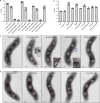McaA and McaB control the dynamic positioning of a bacterial magnetic organelle
- PMID: 36163114
- PMCID: PMC9512821
- DOI: 10.1038/s41467-022-32914-9
McaA and McaB control the dynamic positioning of a bacterial magnetic organelle
Abstract
Magnetotactic bacteria are a diverse group of microorganisms that use intracellular chains of ferrimagnetic nanocrystals, produced within magnetosome organelles, to align and navigate along the geomagnetic field. Several conserved genes for magnetosome formation have been described, but the mechanisms leading to distinct species-specific magnetosome chain configurations remain unclear. Here, we show that the fragmented nature of magnetosome chains in Magnetospirillum magneticum AMB-1 is controlled by genes mcaA and mcaB. McaA recognizes the positive curvature of the inner cell membrane, while McaB localizes to magnetosomes. Along with the MamK actin-like cytoskeleton, McaA and McaB create space for addition of new magnetosomes in between pre-existing magnetosomes. Phylogenetic analyses suggest that McaA and McaB homologs are widespread among magnetotactic bacteria and may represent an ancient strategy for magnetosome positioning.
© 2022. The Author(s).
Conflict of interest statement
The authors declare no competing interests.
Figures









Similar articles
-
A second actin-like MamK protein in Magnetospirillum magneticum AMB-1 encoded outside the genomic magnetosome island.PLoS One. 2010 Feb 10;5(2):e9151. doi: 10.1371/journal.pone.0009151. PLoS One. 2010. PMID: 20161777 Free PMC article.
-
Interplay between two bacterial actin homologs, MamK and MamK-Like, is required for the alignment of magnetosome organelles in Magnetospirillum magneticum AMB-1.J Bacteriol. 2014 Sep;196(17):3111-21. doi: 10.1128/JB.01674-14. Epub 2014 Jun 23. J Bacteriol. 2014. PMID: 24957623 Free PMC article.
-
Tethered Magnets Are the Key to Magnetotaxis: Direct Observations of Magnetospirillum magneticum AMB-1 Show that MamK Distributes Magnetosome Organelles Equally to Daughter Cells.mBio. 2017 Aug 8;8(4):e00679-17. doi: 10.1128/mBio.00679-17. mBio. 2017. PMID: 28790202 Free PMC article.
-
Magnetosome biogenesis in magnetotactic bacteria.Nat Rev Microbiol. 2016 Sep 13;14(10):621-37. doi: 10.1038/nrmicro.2016.99. Nat Rev Microbiol. 2016. PMID: 27620945 Review.
-
Genetics and cell biology of magnetosome formation in magnetotactic bacteria.FEMS Microbiol Rev. 2008 Jul;32(4):654-72. doi: 10.1111/j.1574-6976.2008.00116.x. Epub 2008 Jun 2. FEMS Microbiol Rev. 2008. PMID: 18537832 Review.
Cited by
-
Fast automatic multiscale electron tomography for sensitive materials under environmental conditions.Commun Eng. 2025 Aug 11;4(1):149. doi: 10.1038/s44172-025-00482-7. Commun Eng. 2025. PMID: 40790165 Free PMC article.
-
Isolation and cultivation of a novel freshwater magnetotactic coccus FCR-1 containing unchained magnetosomes.Commun Biol. 2025 Mar 27;8(1):505. doi: 10.1038/s42003-025-07981-5. Commun Biol. 2025. PMID: 40148482 Free PMC article.
-
Functional expression of foreign magnetosome genes in the alphaproteobacterium Magnetospirillum gryphiswaldense.mBio. 2023 Aug 31;14(4):e0328222. doi: 10.1128/mbio.03282-22. Epub 2023 Jun 15. mBio. 2023. PMID: 37318230 Free PMC article.
-
Bacterial Organelles in Iron Physiology.Mol Microbiol. 2024 Dec;122(6):914-928. doi: 10.1111/mmi.15330. Epub 2024 Nov 15. Mol Microbiol. 2024. PMID: 39545931 Free PMC article. Review.
-
Linking morphology, genome, and metabolic activity of uncultured magnetotactic Nitrospirota at the single-cell level.Microbiome. 2024 Aug 24;12(1):158. doi: 10.1186/s40168-024-01837-6. Microbiome. 2024. PMID: 39182147 Free PMC article.

